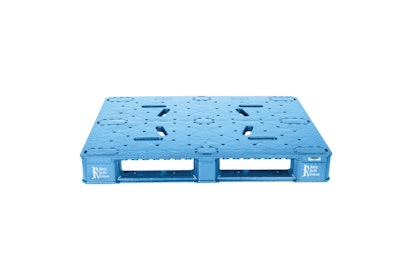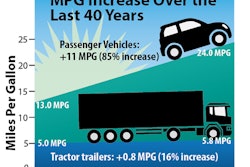
It sounds like something out of a hard-boiled, urban crime novel. A Baltimore private eye was hired to track down a rash of plastic pallet thefts, including some belonging to PepsiCo as well as a dairy and a bakery. His investigation led to a recycling center in the Washington DC suburb of Hyattsville, MD, where he discovered 2.8 million pounds of stolen, trademarked plastic.
According to a December 2014 whitepaper by Rehrig Pacific, “A new breed of criminal is heisting them off loading docks and from back alleys, and then selling them to underground recycling networks. Milk crates, plastic pallets, bakery trays, beverage shells and other containers made from high-density polyethylene (HDPE) and polypropylene are disappearing at a rate that is costing retailers and consumer packaged goods (CPG) companies an estimated $500 million per year.”
That loss, the paper explains, trickles throughout the supply chain, from manufacturer to retailer to consumer. “The theft of reusable plastics is big business with an organization and infrastructure that allows thieves to swipe, process and resell large quantities of plastics. And it’s growing nationwide as the value of petroleum-derived plastic increases along with the price of oil and natural gas.”
By selling to illegal recyclers, the thieves can earn 10 to 12 cents a pound. The recyclers then shred the plastic into pellets and sell it for export at 30 to 50 cents a pound. Meanwhile, the original owners (or leasers) of the plastics have to replace their assets and the cycle continues.
“If goods and services are valuable, bad people will do bad things,” says Kaley Parkinson, director of applied technology for sales and business development at Rehrig Pacific. Working in partnership with Rehrig, PepsiCo’s North American Beverage Unit purchased 200,000 shells equipped with radio frequency identification (RFID) tags and tested them at seven plants in the southeastern corridor. The results gave the company clear knowledge of how many shells went out and how many came back at any point in time.
“They have a lot of reusable assets,” he explains. “We also are the provider of their shells and delivery pallets. We worked on a combination RFID and global positioning system (GPS) program for them in the southeastern region and they saw a 25 percent reduction in repurchases year over year, saving tens of millions of dollars.”
Being technology agnostic, Parkinson adds, is important: “Use solutions that fit the application. Each supply chain is unique, so we look for the most cost-effective ways to produce results.”
In the Warehouse
Pallets need to be tracked not only between delivery points, but also in the warehouse or distribution center. If a pallet full of product is moved without being registered in the system, how do you find it when it’s time to load into an outgoing vehicle?
There are a number of ways to handle this. At C.H. Robinson facilities, for example, as soon as the pallet enters the facility, it’s assigned an ID number, explains Ray Hurtado, general manager. “The barcode containing the ID is scanned into our internal warehouse management system (WMS) and is scanned throughout its entire journey using handheld scanners. Not only is the pallet assigned an identification number, but C.H. Robinson also logs the current condition of the pallet at each point that it is moving in, around and out of the facility. Warehouse representatives track the pallet’s specific warehouse location, the dock doors it leaves from and its final destination.”
In addition, Hurtado says, each pallet in the warehouse is manually scanned each week to ensure that the inventory matches the system data.
Complicating the issue is the type of product being tracked. In the food industry, for instance, tracking is vital, says Joe Harris, product line manager at TAKE Supply Chain. One of TAKE’s customers is Welch’s, the 146-year-old company best known for its grape products.
“At Welch’s, each pallet contains an RFID tag that can be scanned by warehouse personnel to keep track of palletized material movements within the warehouse, from receiving vendor shipments, packaging production output, sorting packaged material and shipping to distribution centers,” Harris says. “The way our customers label pallets can vary. For example, we have customers that use the more traditional method of creating inventory license plate numbers (LPNs) and assigning these numbers to containers to use as a tracking number for palletized material. If the customer wants to move and keep track of palletized material within the warehouse, we offer a set of inventory transactions using LPN, as well as inventory transactions using lot/sublot control.”
Tom O’Boyle, director of RFID at Barcoding, Inc., says that customers often have one of two key issues. When receiving pallets, it’s “primarily to validate that the contents of the pallet are as expected by the receiving company.” The other, he adds, is “pallet put-away location within the warehouse. Confusion and cost go up as customers move the pallet within their warehouse.”
For the first issue, he suggests using RFID tags and linking the pallet contents to the RFID tag, which allows a user with the right RFID infrastructure to read and validate the contents immediately at the dock. “This gives the user instant knowledge, and allows for automatic receipt of the palletized load without manual breakdown or hunting, [or] counting the cartons or units.”
To solve the pallet put-away problem, O’Boyle says a barcode system to log the pallet’s location is the first step. That reveals where the pallet is within the warehouse. “If a worker moves or shifts the pallet without the logged event, an RFID reader using the locate function [which has Geiger counter properties] reduces the hunting time by leading the user to the pallet once the RFID tag is within view.”
On the Road
Tracking pallets on the road is a bit different than in the warehouse, O’Boyle explains, saying there are two primary options.
“First, provide a method to link the pallet to the truck ID. Then, using the carrier’s system, track the truck ID to its destination. Second, place a special active RFID tag on the pallet that can track using the cellular and GPS system. This tag, which needs to be recovered at the end of the process due to expense, can track a pallet while it’s on or in a truck. Usually, the second method is used for high-value goods. The tag transmits primarily on movement, so if the pallet sits for months, it sends its location occasionally. Once the tag is moving (as sensed by an onboard accelerometer), its position changes are transmitted more frequently.”
Leased Pallets
Leased pallets bring about their own set of complexities. First, there’s more responsibility to get the leased pallets back to the supplier. This, says O’Boyle, means RFID and scanning technologies must be used since the customer now has an asset that must be returned.
TAKE Supply Chain’s Harris says that, “when using leased pallets, the customer is purchasing into a network. After the pallets arrive at their destination, the leasing company must be notified so that the pallets can be picked up and transported to a depot facility.” There, they are cleaned, inspected and repaired before they are sent to another customer.
“If you’re leasing your pallets,” Harris advises, “You want to make sure that your customers contact the pallet leasing company when they are finished using them. Your organization is being charged until the leased pallets are returned to the network. In addition, the more quickly pallets are returned, the sooner they are available when you need to ship more material to your customers.”
Making the Grade
Pallets are rated A or B. Grade A pallets are newer and in peak condition, says C.H. Robinson’s Hurtado. “They are commonly used in retail where they often sit out on the selling floor and become part of the display. Grade B pallets are more cost-effective, and are used, will be reused and are reinforced over time.”
Sometimes pallets need a little extra care, he says. “Some international shipments that utilize wood pallets require heat treatments that treat the wood for environmentally harmful insects. This ensures that pests are not transported and introduced into other countries. These pallets require a special seal that indicates to customers that the pallet was heat-treated according to country regulations.”















